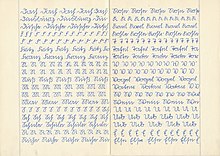German writing
The term German script is either used as a collective term for some broken scripts with which German texts were preferably written and printed from the 16th to the 20th century, or serves as the name of one of these scripts. With regard to cursive , the term German cursive is also used , depending on the context, both as a collective term and as a single name.
Fonts
A decade-long antiqua-Fraktur dispute was conducted about its official use in German authorities and school curricula , in which the Antiqua (also Germanized Altschrift ) finally replaced the familiar German script (including the frequently printed Fraktur ) by the standard script decree in the Third Reich. In order to make it clear that the written forms were not used exclusively in Germany , the term neo-Gothic script was also suggested in the paleographic discussion . In everyday language , some of these fonts are now also referred to as old German script or old German script .
German script usually means one or more of these scripts , depending on the context :
Pamphlets
- Schwabacher - In the 15th and early 16th centuries, the predominant type in German-speaking countries.
- Fraktur - the most widely used printed font in German-speaking countries from the middle of the 16th to the beginning of the 20th century. It was the official publication for printed matter in the German Reich several times . In the time of National Socialism , until 1940/41, officials insisted that the script be used as a “form of expression of conscious German thinking”.
- Antiqua from 1941 (see Antiqua-Fraktur-Streit ).
- More broken scripts .
Cursive fonts
- German chancellery script - used for official documents until the 19th century
- Deutsche Kurrentschrift - traffic writing in the 18th and 19th centuries
- German cursive script - introduced as a school script at the beginning of the 20th century
- Sütterlin script - starting school script from 1928
- Deutsche Verkehrsschrift or Deutsche Volksschrift - a variant of the Sütterlin script as the starting school script from 1935 to 1941
- German normal script - further development of the Sütterlin script as the original school script from 1941 to 1953
- Offenbacher script - was taught as a second handwriting script in some German schools from 1945 to the early 1960s.
German script is also the name of some fonts from the years 1890 to 1940, such as Rudolf Koch's 1906 "Deutsche Schrift" (so-called "Koch Fraktur").
See also
- Output font (German normal font) - Latin school output font from 1941; no broken script!
- Textura , the most important font for books and inscriptions in all of Europe between the 12th century and the 15th century, more modern variants since the 19th century also in Germany
- German alphabet - 26 letters of the Latin alphabet plus umlauts and ß
- Latin Paleography - History of the Latin scripts, including the broken scripts
- Runes - Germanic characters; verifiable for the 2nd to 12th centuries, there are no German scripts
literature
- The blue fibula. Guide to the Sütterlin and German cursive script. Brune - Mettker printing and publishing company, Wilhelmshaven without year. ISBN 3-930510-13-8 .
Web links
Individual evidence
- ^ Deutsche Reichsbahn-Gesellschaft (ed.): Official Gazette of the Reichsbahndirektion Mainz of April 13, 1935, No. 16. Announcement No. 171, p. 64.

